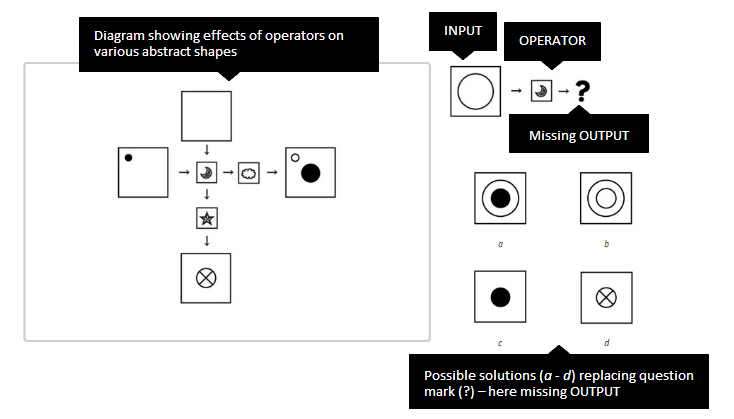Diagrammatic Reasoning Test (ART)
As today world becomes more and more complex and cognitively demanding there is a higher demand for employees who have inner resources necessary for successfully dealing with this constantly growing complexity. The Diagrammatic Reasoning Test (DRT) enables to measure one of the most important psychological qualities that enhance employees’ ability to manage complexity and intricate cognitive niches of modern jobs.
WHAT DOES DIAGRAMMATIC REASONING MEASURE?
DRT measures general mental ability (GMA). GMA is one of the best predictors of job and training performance across different types of jobs.
“that, among other things, involves the ability to reason, plan, solve problems, think abstractly, comprehend complex ideas, learn quickly and learn from experience” (Gottfredson, 1994, p. 13)
WHO DO WE RECOMMEND IT FOR?
DRT can be used as a stand-alone measure in a high-volume recruitment program, or as one of methods used in final rounds of selection process. It is suitable for jobs of higher complexity (e.g., managers and specialists). It is a favorable cost-effectiveness ratio in comparison to other selection methods.
WHAT IS AN ABSTRACT REASONING TEST?
DIAGRAMMATIC REASONING TEST (DRT) measures an ability to quickly learn and identify logical rules and apply them in assessing a situation and solving problems. It is predictive of performance on positions that require both good strategic and analytic thinking – the ability to quickly grasp the bigger picture and also understand implications of given constraints (e.g., managers, programmers, project managers, analysts, etc.).
How does Diagrammatic Reasoning Test work?
Testing from test taker’s home or under controlled testing conditions. Available in 10+ languages (E.g.: English, Czech, German, Hungarian, Polish, Serbian, Slovakian, Romanian, Russian etc.).
Fill in online on our user-friendly interface. DRT consists of 24 logical problems divided into 6 blocks and 2 subtests with 18-minute time limit.
Automatically generated feedback report for both the test taker and the test user. Test results are compared to local or international norm group of more than 4000 individuals.
Simple Item 1
In this type of test item a testee is presented with an information panel which describes several operators (rules) and a panel with several examples illustrating the manner how these operators change the sequence of characters (letters and numerals). On the basis of such information his/her task is to replace one or more question marks (?) which represent the missing INPUTS, OPERATORS or OUTPUTS with one of the proposed solutions.

Simple Item 2
In this type of test item a testee is presented with diagrams showing effects of operators (rules) on various abstract shapes. Testee’s task is to derive a function of individual operators from these diagrams at first and then, based on this knowledge, substitute question marks (?) which represent the missing OUTPUTS by one of the offered solutions.

How will DRT help your organisation and employees?
Selection purposes
It is most useful in situations when you want to estimate what is the candidate’s cognitive horsepower and to size up whether his/her intellectual abilities are sufficient for managing the job he/she is aspiring for.
Target group
DRT is suitable for jobs of higher complexity (e.g., engineers, IT, specialists, etc.).
Increasing employee success
By incorporating outputs from DRT into your hiring decision making process you can increase the odds that selected candidates will successfully do their job.
Looking for cognitive tests?
See the tests developed by Assessment Systems International. Request a free login for your company or contact us for more information.